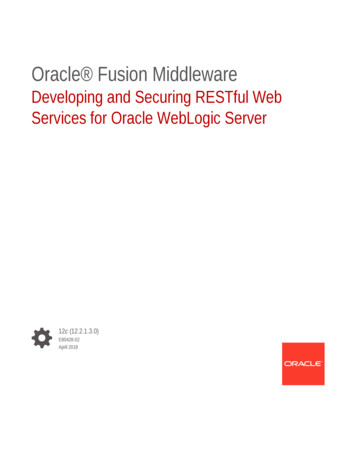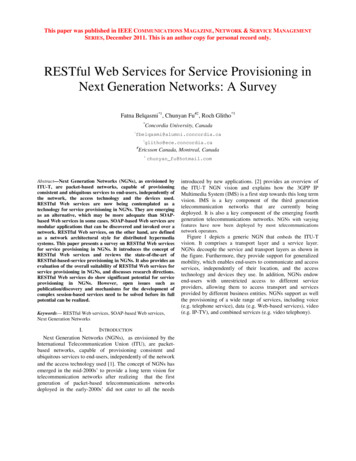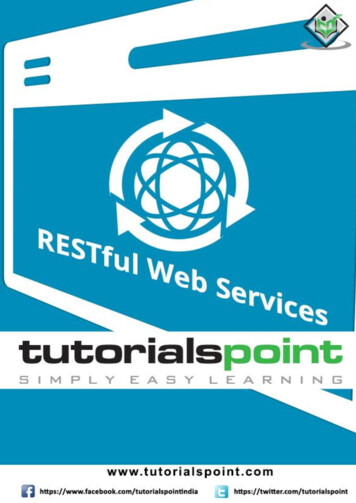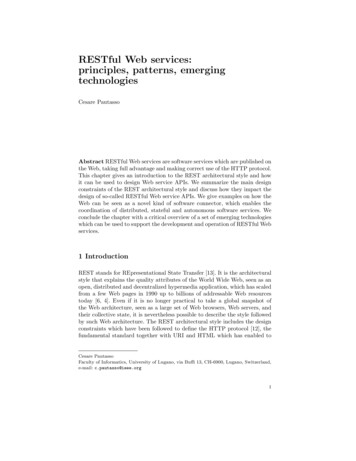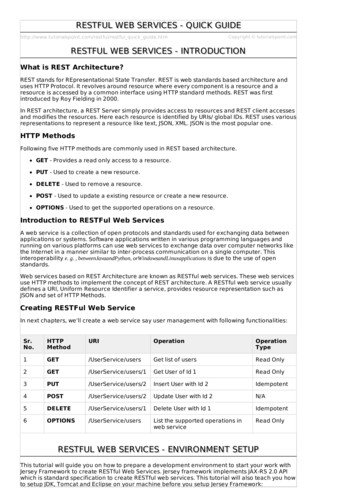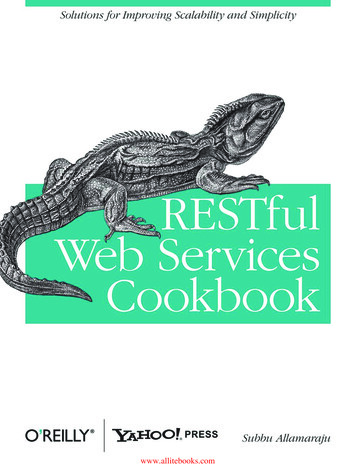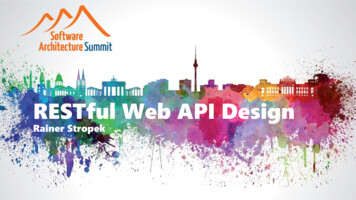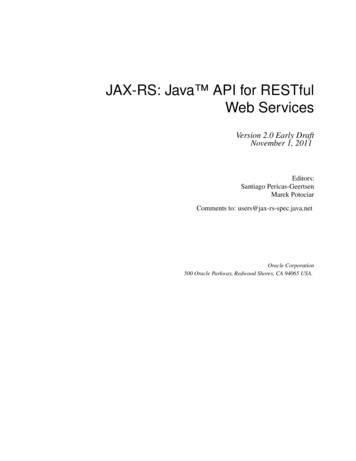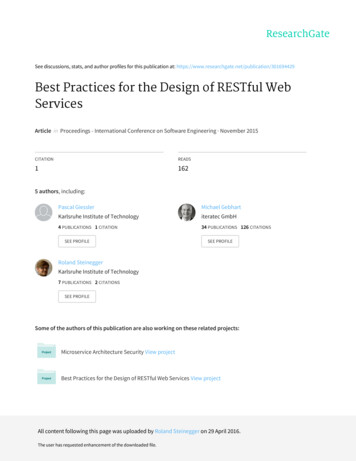
Transcription
RESTEasy JAX-RSRESTFul WebServices for Java2.2.1.GA
Preface . vii1. Overview . 12. License . 33. Installation/Configuration . 53.1. Standalone Resteasy . 53.2. Configuration Switches . 63.3. javax.ws.rs.core.Application . 83.4. RESTEasy as a ServletContextListener . 93.5. RESTEasy as a servlet Filter . 103.6. Install/Config in JBoss 6-M4 and Higher . 113.7. RESTEasyLogging . 114. Using @Path and @GET, @POST, etc. . 134.1. @Path and regular expression mappings . 145. @PathParam . 175.1. Advanced @PathParam and Regular Expressions . 185.2. @PathParam and PathSegment . 186. @QueryParam . 217. @HeaderParam .8. Linking resources .8.1. Link Headers .8.2. Atom links in the resource representations .8.2.1. Configuration .8.2.2. Your first links injected .8.2.3. Customising how the Atom links are serialised .8.2.4. Specifying which JAX-RS methods are tied to which resources .8.2.5. Specifying path parameter values for URI templates .8.2.6. Securing entities .8.2.7. Extending the UEL context .8.2.8. Resource facades .9. @MatrixParam .10. @CookieParam .11. @FormParam .12. @Form .13. @DefaultValue .14. @Encoded and encoding .15. @Context .16. JAX-RS Resource Locators and Sub Resources .17. JAX-RS Content Negotiation .17.1. URL-based negotiation .18. Content Marshalling/Providers .18.1. Default Providers and default JAX-RS Content Marshalling .18.2. Content Marshalling with @Provider classes .18.3. Providers Utility Class .19. JAXB providers 16165iii
RESTEasy JAX-RS19.1. JAXB Decorators .19.2. Pluggable JAXBContext's with ContextResolvers .19.3. JAXB XML provider .19.3.1. @XmlHeader and @Stylesheet .19.4. JAXB JSON provider .19.5. JAXB FastinfoSet provider .19.6. Arrays and Collections of JAXB Objects .19.6.1. JSON and JAXB Collections/arrays .19.7. Maps of JAXB Objects .19.7.1. JSON and JAXB maps .19.7.2. Possible Problems with Jettison Provider .19.8. Interfaces, Abstract Classes, and JAXB .20. Resteasy Atom Support .20.1. Resteasy Atom API and Provider .20.2. Using JAXB with the Atom Provider .21. Atom support through Apache Abdera .21.1. Abdera and Maven 6898921.2. Using the Abdera Provider . 89JSON Support via Jackson . 9522.1. Possible Conflict With JAXB Provider . 97Multipart Providers . 9923.1. Input with multipart/mixed . 9923.2. java.util.List with multipart data . 10123.3. Input with multipart/form-data . 10123.4. java.util.Map with multipart/form-data . 10223.5. Input with multipart/related . 10223.6. Output with multipart . 10323.7. Multipart Output with java.util.List . 10423.8. Output with multipart/form-data . 10523.9. Multipart FormData Output with java.util.Map . 10623.10. Output with multipart/related . 10623.11. @MultipartForm and POJOs . 10823.12. XML-binary Optimized Packaging (Xop) . 10923.13. Note about multipart parsing and working with other frameworks . 11123.14. Overwriting the default fallback content type for multipart messages . 112YAML Provider . 113String marshalling for String based @*Param . 11525.1. StringConverter . 11525.2. StringParamUnmarshaller . 118Responses using javax.ws.rs.core.Response . 121Exception Handling . 12327.1. Exception Mappers . 12327.2. Resteasy Built-in Internally-Thrown Exceptions . 12427.3. Overriding Resteasy Builtin Exceptions . 126
28. Configuring Individual JAX-RS Resource Beans .29. GZIP Compression/Decompression .30. Resteasy Caching Features .30.1. @Cache and @NoCache Annotations .30.2. Client "Browser" Cache .30.3. Local Server-Side Response Cache .31. Interceptors .31.1. MessageBodyReader/Writer Interceptors .31.2. PreProcessInterceptor .31.3. PostProcessInterceptors .31.4. ClientExecutionInterceptors .31.5. Binding Interceptors .31.6. Registering Interceptors .31.7. Interceptor Ordering and Precedence .31.7.1. Custom Precedence .32. Asynchronous HTTP Request Processing .32.1. Tomcat 6 and JBoss 4.2.3 Support 4932.2. Servlet 3.0 Support .32.3. JBossWeb, JBoss AS 5.0.x Support .Asynchronous Job Service .33.1. Using Async Jobs .33.2. Oneway: Fire and Forget .33.3. Setup and Configuration .Embedded Container .Server-side Mock Framework .Securing JAX-RS and RESTeasy .Authentication .37.1. OAuth core 1.0a .37.1.1. Authenticating with OAuth .37.1.2. Accessing protected resources .37.1.3. Implementing an OAuthProvider .Digital Signature Framework .38.1. Maven settings .38.2. Signing API .38.2.1. @Signed annotation .38.3. Signature Verification API .38.3.1. Annotation-based verification .38.4. Managing Keys via a KeyRepository .38.4.1. Create a KeyStore .38.4.2. Configure Restreasy to use the KeyRepository .38.4.3. Using DNS to Discover Public Keys .EJB Integration .Spring Integration .CDI Integration 39.40.41.v
RESTEasy JAX-RS42.43.44.45.46.47.48.49.50.51.vi41.1. Using CDI beans as JAX-RS components .41.2. Default scopes .41.3. Configuration within JBoss 6 M4 and Higher .41.4. Configuration with different distributions .Seam Integration .Guice 2.0 Integration .43.1. Configuring Stage .Client Framework .44.1. Abstract Responses .44.2. Sharing an interface between client and server .44.3. Client Error Handling .44.4. Manual ClientRequest API .44.5. Spring integration on client side .AJAX Client .45.1. Generated JavaScript API .45.1.1. JavaScript API servlet .45.1.2. JavaScript API usage 0045.1.3. MIME types and unmarshalling. .45.1.4. MIME types and marshalling. .45.2. Using the JavaScript API to build AJAX queries .45.2.1. The REST object .45.2.2. The REST.Request class .Maven and RESTEasy .JBoss AS 5.x Integration .JBoss AS 6 Integration .Documentation Support .Migration from older versions .50.1. Migrating from 2.2.0 to 2.2.1 .50.2. Migrating from 2.1.x to 2.2 .50.3. Migrating from 2.0.x to 2.1 .50.4. Migrating from 1.2.x to 2.0 .50.5. Migrating from 1.2.GA to 1.2.1.GA .50.6. Migrating from 1.1 to 1.2 .Books You Can Read 19
PrefaceCommercial development support, production support and training for RESTEasy JAX-RS isavailable through JBoss, a division of Red Hat Inc. (see http://www.jboss.com/).In some of the example listings, what is meant to be displayed on one line does not fit inside theavailable page width. These lines have been broken up. A '\' at the end of a line means that abreak has been introduced to fit in the page, with the following lines indented. So:Let's pretend to have an extremely \long line that \does not fitThis one is shortIs really:Let's pretend to have an extremely long line that does not fitThis one is shortvii
viii
Chapter 1.OverviewJAX-RS, JSR-311, is a new JCP specification that provides a Java API for RESTful Web Servicesover the HTTP protocol. Resteasy is an portable implementation of this specification which can runin any Servlet container. Tighter integration with JBoss Application Server is also available to makethe user experience nicer in that environment. While JAX-RS is only a server-side specification,Resteasy has innovated to bring JAX-RS to the client through the RESTEasy JAX-RS ClientFramework. This client-side framework allows you to map outgoing HTTP requests to remoteservers using JAX-RS annotations and interface proxies. JAX-RS implementation Portable to any app-server/Tomcat that runs on JDK 5 or higher Embeddedable server implementation for junit testing EJB and Spring integration Client framework to make writing HTTP clients easy (JAX-RS only define server bindings)1
2
Chapter 2.LicenseRESTEasy is distributed under the ASL 2.0 license. It does not distribute any thirdparty librariesthat are GPL. It does ship thirdparty libraries licensed under Apache ASL 2.0 and LGPL.3
4
Chapter 3.Installation/ConfigurationRESTEasy is installed and configured in different ways depending on which environment youare running in. If you are running in JBoss AS 6-M4 (milestone 4) or higher, resteasy is alreadybundled and integrated completely so there is very little you have to do. If you are running in adifferent distribution, there is some manual installation and configuration you will have to do.3.1. Standalone ResteasyIf you are using resteasy outside of JBoss AS 6, you will need to do a few manual steps to installand configure resteasy. RESTeasy is deployed as a WAR archive and thus depends on a Servletcontainer. We strongly suggest that you use Maven to build your WAR files as RESTEasy is splitinto a bunch of different modules. You can see an example Maven project in one of the examplesin the examples/ directoryAlso, when you download RESTeasy and unzip it you will see a lib/ directory that contains thelibraries needed by resteasy. Copy these into your /WEB-INF/lib directory. Place your JAX-RSannotated class resources and providers within one or more jars within /WEB-INF/lib or your rawclass files within /WEB-INF/classes.RESTeasy is implemented as a Servlet and deployed within a WAR file. If you open up the WEBINF/web.xml in one of the example projects of your RESTeasy download you will see this: web-app display-name Archetype Created Web Application /display-name servlet servlet-name Resteasy /servlet-name servlet-class letDispatcher /servlet-class init-param param-name javax.ws.rs.Application /param-name param-value com.restfully.shop.services.ShoppingApplication /param-value /init-param /servlet servlet-mapping servlet-name Resteasy /servlet-name url-pattern /* /url-pattern /servlet-mapping 5
Chapter 3. Installation/Confi. /web-app The Resteasy servlet is responsible for initializing some basic components of RESTeasy.3.2. Configuration SwitchesResteasy receives configuration options from context-param elements.Table 3.1.Option NameDefault ValueDescriptionresteasy.servlet.mapping.prefix no defaultIf the url-pattern for theResteasy servlet-mapping isnot /*resteasy.scanfalseAutomatically scan WEB-INF/lib jars and WEB-INF/classesdirectory for both @Providerand JAX-RS resource classes(@Path, @GET, @POSTetc.) and register themresteasy.scan.providersfalseScan for @Provider classesand register themresteasy.scan.resourcesfalseScan for JAX-RS resourceclassesresteasy.providersno defaultA comma delimited list offully qualified @Provider classnames you want to registerresteasy.use.builtin.providerstrueWhether or not to registerdefault, built-in @Providerclasses. (Only available in 1.0beta-5 and later)resteasy.resourcesno defaultA comma delimited list of fullyqualified JAX-RS resourceclass names you want toregisterresteasy.jndi.resourcesno defaultA comma delimited list ofJNDI names which referenceobjects you want to register asJAX-RS resourcesjavax.ws.rs.Applicationno default6
Configuration SwitchesOption NameDefault ValueDescriptionFullyqualifiednameofApplication class to bootstrapin a spec portable wayresteasy.media.type.mappings no defaultReplaces the need for anAccept header by mappingfile name extensions (like.xml or .txt) to a mediatype. Used when the client isunable to use a Accept headerto choose a representation(i.e. a browser). See JAX-RSContent Negotiation chapterfor more details.resteasy.language.mappingsReplaces the need for anAccept-Language header bymapping file name extensions(like .en or .fr) to a language.Used when the client is unableto use a Accept-Languageheader to choose a language(i.e. a browser). See JAX-RSContent Negotiation chapterfor more detailsno defaultThe resteasy.servlet.mapping.prefix context param variable must be set if your servlet-mappingfor the Resteasy servlet has a url-pattern other than /*. For example, if the url-pattern is servlet-mapping servlet-name Resteasy /servlet-name url-pattern /restful-services/* /url-pattern /servlet-mapping Then the value of resteasy-servlet.mapping.prefix must be: context-param param-name resteasy.servlet.mapping.prefix /param-name 7
Chapter 3. Installation/Confi. param-value /restful-services /param-value /context-param 3.3. javax.ws.rs.core.ApplicationThe javax.ws.rs.core.Application class is a standard JAX-RS class that you may implement toprovide information on your deployment. It is simply a class the lists all JAX-RS root resourcesand providers./*** Defines the components of a JAX-RS application and supplies additional* metadata. A JAX-RS application or implementation supplies a concrete* subclass of this abstract class.*/public abstract class Application{private static final Set Object emptySet Collections.emptySet();/*** Get a set of root resource and provider classes. The default lifecycle* for resource class instances is per-request. The default lifecycle for* providers is singleton.* p/ * p Implementations should warn about and ignore classes that do not* conform to the requirements of root resource or provider classes.* Implementations should warn about and ignore classes for which* {@link #getSingletons()} returns an instance. Implementations MUST* NOT modify the returned set. /p ** @return a set of root resource and provider classes. Returning null* is equivalent to returning an empty set.*/public abstract Set Class ? getClasses();/*** Get a set of root resource and provider instances. Fields and properties* of returned instances are injected with their declared dependencies* (see {@link Context}) by the runtime prior to use.* p/ * p Implementations should warn about and ignore classes that do not* conform to the requirements of root resource or provider classes.8
RESTEasy as a ServletContextListener* Implementations should flag an error if the returned set includes* more than one instance of the same class. Implementations MUST* NOT modify the returned set. /p * p/ * p The default implementation returns an empty set. /p ** @return a set of root resource and provider instances. Returning null* is equivalent to returning an empty set.*/public Set Object getSingletons(){return emptySet;}}To use Application you must set a servlet init-param, javax.ws.rs.Application with a fully qualifiedclass that implements Application. For example: servlet servlet-name Resteasy /servlet-name servlet-class letDispatcher /servlet-class init-param param-name javax.ws.rs.Application /param-name param-value com.restfully.shop.services.ShoppingApplication /param-value /init-param /servlet If you have this set, you should probably turn off automatic scanning as this will probably resultin duplicate classes being registered.3.4. RESTEasy as a ServletContextListenerThe initialization of RESTEasy can be performed within a ServletContextListener instead of withinthe Servlet. You may need this if you are writing custom Listeners that need to interact withRESTEasy at boot time. An example of this is the RESTEasy Spring integration that requires aSpring ServletContextListener. The Bootstrapclass is a ServletContextListener that configures an instance of an ResteasyProviderFactory9
Chapter 3. Installation/Confi.and Registry. You can obtain instances of a ResteasyProviderFactory and Registryfrom the ServletContext attributes org.jboss.resteasy.spi.ResteasyProviderFactory andorg.jboss.resteasy.spi.Registry. From these instances you can programmatically interact withRESTEasy registration interfaces. web-app listener listener-class Bootstrap /listener-class /listener !-- ** INSERT YOUR LISTENERS HERE!!!! -- servlet servlet-name Resteasy /servlet-name servlet-class letDispatcher /servlet-class /servlet servlet-mapping servlet-name Resteasy /servlet-name url-pattern /resteasy/* /url-pattern /servlet-mapping /web-app 3.5. RESTEasy as a servlet FilterThe downside of running Resteasy as a Servlet is that you cannot have static resources like .htmland .jpeg files in the same path as your JAX-RS services. Resteasy allows you to run as a Filterinstead. If a JAX-RS resource is not found under the URL requested, Resteasy will delegate backto the base servlet container to resolve URLs. web-app 10
Install/Config in JBoss 6-M4 and Higher filter filter-name Resteasy /filter-name filter-class spatcher /filter-class init-param param-name javax.ws.rs.Application /param-name param-value com.restfully.shop.services.ShoppingApplication /param-value /init-param /filter filter-mapping filter-name Resteasy /filter-name url-pattern /* /url-pattern /filter-mapping /web-app 3.6. Install/Config in JBoss 6-M4 and HigherRESTEasy is preconfigured and completely integrated with JBoss 6-M4 and higher. You can useit with EJB and CDI and you can rely completely on JBoss for scanning for your JAX-RS servicesand deploying them. All you have to provide is your JAX-RS service classes packaged within aWAR either as POJOs, CDI beans, or EJBs and provide an empty web.xml file as follows: web-app version "3.0" xmlns "http://java.sun.com/xml/ns/javaee"xmlns:xsi emaLocation "http://java.sun.com/xml/ns/javaee http://java.sun.com/xml/ns/javaee/web-app 3 0.xsd" /web-ap
class files within /WEB-INF/classes. RESTeasy is implemented as a Servlet and deployed within a WAR file. If you open up the WEB-INF/web.xml in one of the example projects of your RESTeasy download you will see this: web-app display-name Archetype Created Web Application /display-name servlet servlet-name Resteasy /servlet-name servlet .
